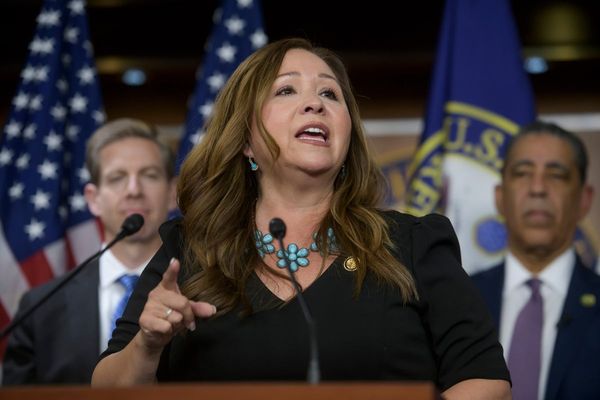
For Donna Thomas, smokestacks are a typical sight from her home in Fort Bend County, Texas. Since she was a child, she has seen the coal and natural gas-powered W.A. Parish Generating Station puff clouds of haze during the day and light up brightly at night. The facility — which has been around since 1958 — is both part of the background and all she thinks about.
Thomas is not alone. For decades, residents have expressed concerns over the pollution emitted from the Parish coal plant — a separate facility from the natural gas plant — and called for its closure. The plant, located about 30 miles southwest of downtown Houston, is ranked by Texas environmental regulators as one of the worst polluters in the state for certain hazardous emissions. These include mercury, a toxic heavy metal particularly harmful for children and pregnant people.
This year, mercury has been top of mind for environmental activists and residents like Thomas. In April, President Donald Trump announced an exemption for companies from implementing stricter Biden-era mercury regulations for two years. Of the 163 eligible coal plants, 11 are in Texas and six have been approved, including Parish’s operator, NRG Energy. In Missouri and Illinois, five coal plants have been exempted, and in Pennsylvania, all 12 of the coal plants seeking approval have been approved.
Then in July, Trump exempted chemical companies for two years from Biden’s 2024 HON Rule, a set of regulations that control hazardous air emissions from chemical plants called the Hazardous Organic National Emission Standards for Hazardous Air Pollutants.
The Trump administration determined the exemptions are in the country’s best interest and represent a burden on industry, and that the technology is not available to meet stricter regulations. Companies like NRG agree.
However, critics say the Biden administration’s 2024 Mercury and Air Toxics Standards — called MATS for short — and the HON Rule were long overdue and the two-year delay in implementing them is merely a tactic to protect industry profit margins at the expense of public health.
Moreover, critics point out that the MATS delay may be giving companies the freedom to ignore toxic air emission rules until the Trump administration repeals the Biden-era regulations altogether. In June, the Environmental Protection Agency under Trump proposed a rule to eliminate the 2024 MATS rule completely.
The two rules together have set off alarm bells for experts and environmentalists in Texas, home to one of the world’s largest petrochemical sectors and 11 coal-powered plants. The exemptions will run from 2027 — when the Biden rules were supposed to take effect — to 2029.
“We know these rollbacks are not good for anyone, especially for those that are community fenceline,” said Thomas, also the founder and president of the Fort Bend Environmental — a grassroots organization focused on environmental justice. “We have around 1,000 homes within three miles of Parish, so that’s going to affect all of them.”
A Two-Year Delay
The EPA has been working on stricter environmental regulations for chemical plants since the early 1990s. Only in 2020 did Biden’s EPA begin drafting new rules in earnest.
But owners of the chemical plants should not act so surprised, said Neil Carman, a former regulator for the Texas Commission on Environmental Quality.
“The chemical industry has known for decades that this was all coming, but they don’t like rules, because it means they have to put on more pollution control and they have to do more leak inspections,” said Carman, now the clean air director for the Texas chapter of the Sierra Club. “These plants will always tell you safety first, safety first, but then you run into this thing called money.”
Of the 79 chemical facilities in Texas requesting exemptions, 15 have been approved, including 13 along the Gulf Coast and the so-called petrochemical corridor.
Carman pointed out that the heads of chemical companies have been in talks with Trump’s EPA since the election. In March, the administration announced that companies could apply for exemption from MATS, HON and seven other sets of emissions standards.
That same month, EPA Administrator Lee Zeldin met with Dow Inc. Chairman-CEO Jim Fitterling to discuss regulations imposed by the Biden administration, according to public records and emails obtained by the Sierra Club.
In one email sent on March 17, Dow reps asked to discuss “clarity” on the EPA’s recent announcement that it will reconsider the HON rule and “Dow has met with the Office of Air and Radiation regarding an extension of the current compliance deadline, which is impossible to meet.”
In May, Zeldin met with Fitterling and other chemical company CEOs to discuss the industry at large. Then in July, Trump announced the exemptions for HON, including for two chemical plants in Louisiana and one in Seadrift, Texas, operated by Dow and its subsidiary Union Carbide.
In a statement to Capital & Main, a Dow spokesperson said that “safety and integrity are at the core of both companies’ operations” and the “extensions are appropriate and necessary to address the technical challenges and to ensure the continued safe and efficient operation of these facilities.”
Carman doesn’t buy it. He worked as an environmental regulator in Texas for 12 years. Even then, he said, companies never seemed to be able to find the budget to limit their emissions and chemical leaks. For him, it’s still the cost.
“A lot of these are old plants and so when they go in and do all this work,” Carman said, “they have to find a place where they’re going to put in new controls and they have to engineer it. They have to design it all. It’s months of planning, but these rules were out there. They knew they were coming. They just want two more years of delay.”
Limiting Mercury
When the EPA implemented the 2012 MATS rule, mercury emissions dropped 86% — or four tons — in five years.
In 2024, Biden’s EPA approved a rule to strengthen MATS by tightening the emissions standards for mercury by another 70% and reducing pollutants discharged through wastewater from coal-fired plants by more than 660 million pounds per year.
The rule could prevent as many as 11,000 premature deaths, 2,800 cases of chronic bronchitis and 130,000 asthma attacks, according to the EPA under Biden.
However, in April, Trump approved the exemptions for 47 coal-powered plants across the nation. As of mid-August, 70 are now exempted, including Parish.
“These rules were just so critically important to people’s health,” said Surbhi Sarang, senior attorney for the Environmental Defense Fund. The Trump administration “was doing this process that was just not transparent. I mean, there was no process. Whereas in rulemaking, there’s public comment. This is just like a presidential action that was kind of taken in a vacuum and then announced.”
In response to the exemption, Erik Linden, senior director of communications at NRG, said the time is needed and will be used to evaluate the technology for air quality systems and monitoring equipment for compliance.
“All existing MATS emission controls will be properly maintained and remain in service,” Linden said of the current MATS rules that began in 2012. The exemption would give NRG until 2029 to implement the changes.
However, in July, Trump’s EPA proposed eliminating Biden’s rule entirely by the end of the year. Interested parties had three weeks to submit comments, and the Environmental Defense Fund’s request for an extension was denied.
“Rule-making usually takes 12-18 months if not longer,” Sarang said. “They’re moving very quickly.”
All of this is alarming for residents living near industry. With the extent of the changes to environmental regulations coming down from the Trump administration, there’s a lot for Thomas, the Parish generating station neighbor, to process. But she hasn’t given up. Increasingly, Thomas is talking to her neighbors and fellow residents about fighting back.
This means sending letters to representatives in Texas and in Washington, D.C. Thomas said it pays to be loud.
Parish is “going to do the same thing it’s been doing,” Thomas said. “If the EPA does not put a stop to these [emissions] getting out, then everyone is going to pay for this with their lives and in their water and in their air.”







